Caryopteris Blue Mist Shrub: How To Grow A Blue Mist Shrub

Caryopteris blue mist shrub is a shrub also classified as a “sub-shrub” with woody stems that partially die back in the winter, or even entirely all the way to the crown of the plant. A hybrid or cross between Caryopteris x clandonensi, this shrub is non-native to any area and hails from the family Lamiaceae. It may also be found under the names blue mist shrub, bluebeard, and blue spirea. Let's learn more about how to care for blue mist shrubs. This airy shrub has aromatic green, silvery green, yellow, or green and white foliage depending upon the cultivar. Caryopteris blue mist shrub's prized feature, however, is the blue to purple blooms, flowering in late summer all the way up until the first heavy winter frost. The flowers on growing blue mist shrubs are great attractors for pollinators such as butterflies and bees.
How to Grow a Blue Mist Shrub
Blue mist shrub planting can occur in USDA zones 5 through 9 and is deciduous in most regions, although it may remain evergreen in mild climates. This shrub will grow to about 2 to 3 feet (61-91 cm.) high by 2 to 3 feet (61-91 cm.) across with a moderately fast growth rate. Other information on how to grow a blue mist shrub advises planting in a sunny exposure in a well-draining, loose, loamy soil. Some varieties of Caryopteris blue mist shrub to consider planting in the home landscape are:
- ‘Longwood Blue' - sky blue fragrant blooms and is a taller variety at about 4 feet (1 m.) tall
- ‘Worchester Gold' - golden foliage that is aromatic if crushed and lavender flowers
- ‘Dark Knight' - deep blue blooms on a medium-sized plant of 2 to 3 feet (61-91 cm.)
Care for Blue Mist Shrubs
Caring for blue mist shrubs is quite easy as long as the plant gets plenty of sun and is planted in the appropriate zone listed above. Blue mist shrubs are drought-tolerant, and, hence, requires an average amount of irrigation. Overly fertilizing will result in a plant that is overblown and disorderly. Pruning the blue mist shrub of any deadened branches, due to harsh winter and freezing, should be postponed until the plant begins to leaf out in the spring. The entire shrub may be cut back to the ground in the spring and, in fact, enlivens the specimen and fosters a more attractive, evenly rounded shape. Flowering occurs on new growth. Although this little beauty is a pollinator attractor, deer are generally not interested in browsing its leaves and stems.
Gardening tips, videos, info and more delivered right to your inbox!
Sign up for the Gardening Know How newsletter today and receive a free copy of our e-book "How to Grow Delicious Tomatoes".

Amy Grant has been gardening for 30 years and writing for 15. A professional chef and caterer, Amy's area of expertise is culinary gardening.
-
 Try The Trend – Turn Any Bed Into A Keyhole Garden With This Clever In-Ground Composter
Try The Trend – Turn Any Bed Into A Keyhole Garden With This Clever In-Ground ComposterKeyhole gardening is an efficient and sustainable practice that saves space. Get started on this DIY project quickly and easily with an in-ground composter.
By Bonnie L. Grant
-
 4 Superfast Composting Methods: Turn Waste Into Garden Gold In 30 Days Or Less
4 Superfast Composting Methods: Turn Waste Into Garden Gold In 30 Days Or LessTry the fastest composting methods to turbocharge your pile and transform kitchen scraps and garden waste into finished compost in just a few weeks.
By Mary Ellen Ellis